Evaluation of the Contemporary Hospitality Industry and Tourism
VerifiedAdded on 2020/10/23
|13
|1843
|374
Report
AI Summary
This report provides a comprehensive overview of the contemporary hospitality industry, examining its core components and evolution within the travel and tourism sector. It delves into the key milestones in the development of the travel and tourism industry, highlighting the changing purposes and modes of travel across different periods, from the 1600s to the present day. The report explores the definition and scope of the hospitality industry, emphasizing its dependence on leisure time and discretionary income. It also analyzes the elements of the travel and tourism industry, distinguishing between direct and indirect elements and their interdependencies. The report further covers current patterns and key trends, as well as factors influencing the popularity of global destinations. It references various academic sources to support its analysis. The report is structured to evaluate the development of the travel and tourism industry and how different elements combine to render a tourism experience, with a brief explanation about the factors driving tourist behaviour.
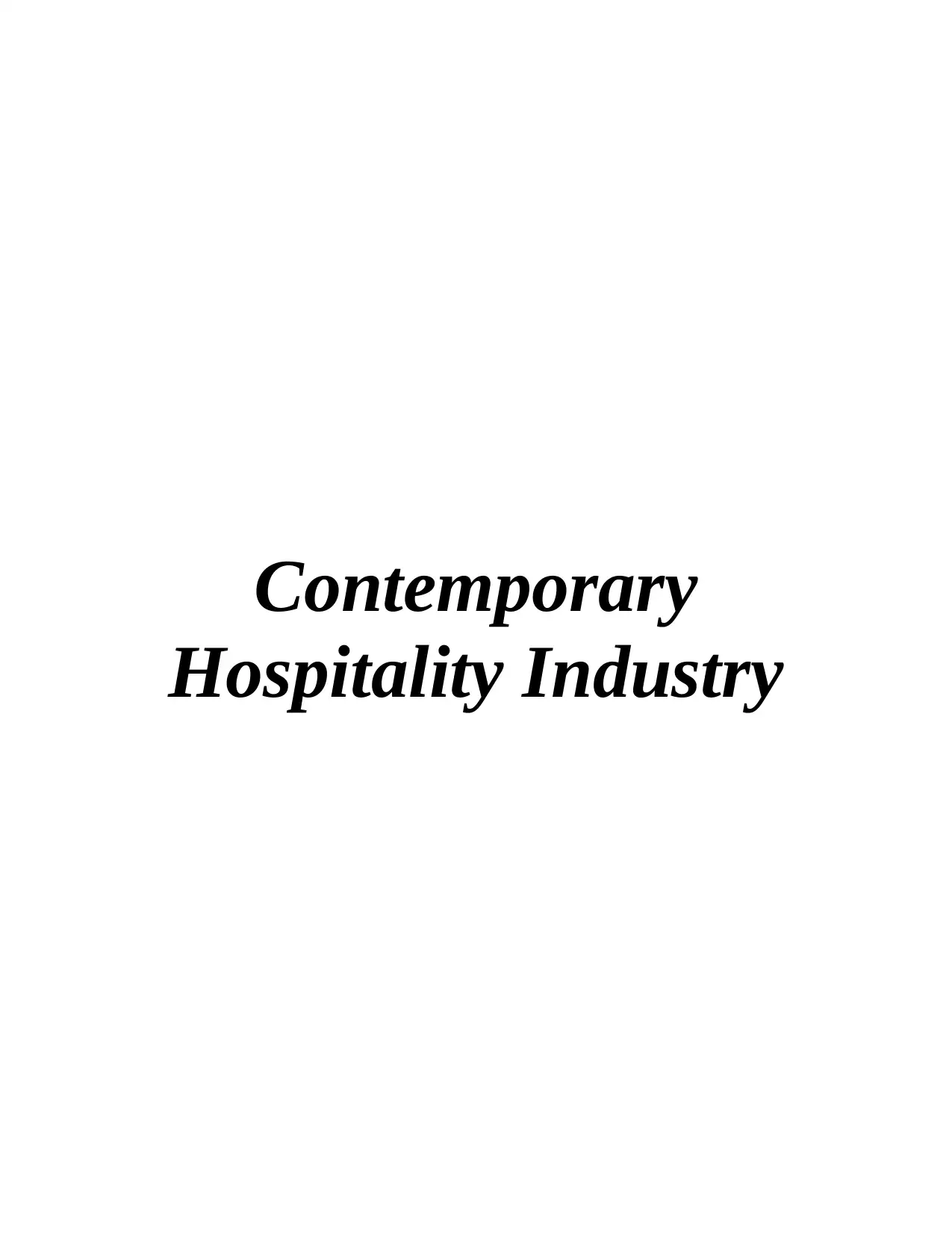
Contemporary
Hospitality Industry
Hospitality Industry
Paraphrase This Document
Need a fresh take? Get an instant paraphrase of this document with our AI Paraphraser
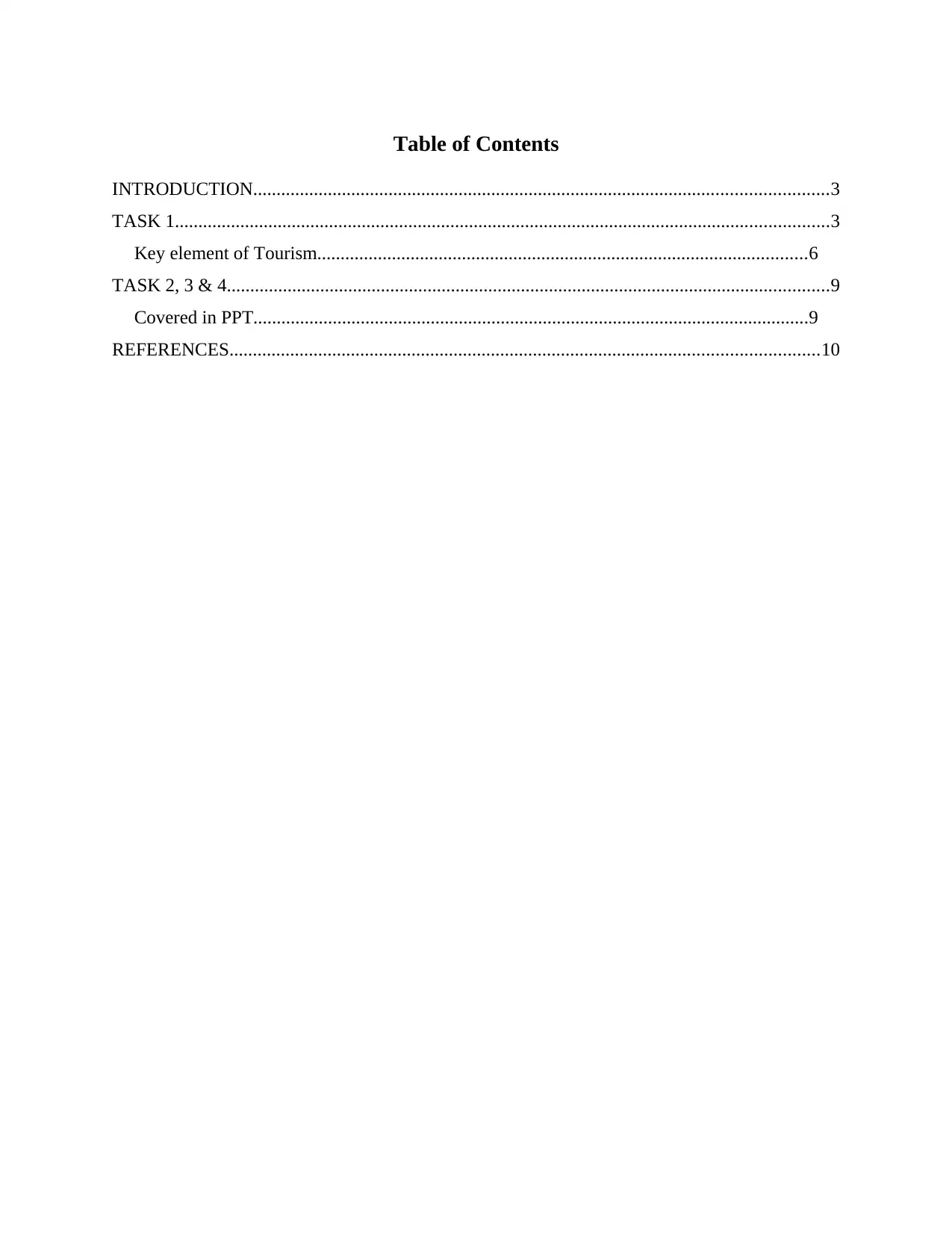
Table of Contents
INTRODUCTION...........................................................................................................................3
TASK 1............................................................................................................................................3
Key element of Tourism.........................................................................................................6
TASK 2, 3 & 4.................................................................................................................................9
Covered in PPT.......................................................................................................................9
REFERENCES..............................................................................................................................10
INTRODUCTION...........................................................................................................................3
TASK 1............................................................................................................................................3
Key element of Tourism.........................................................................................................6
TASK 2, 3 & 4.................................................................................................................................9
Covered in PPT.......................................................................................................................9
REFERENCES..............................................................................................................................10
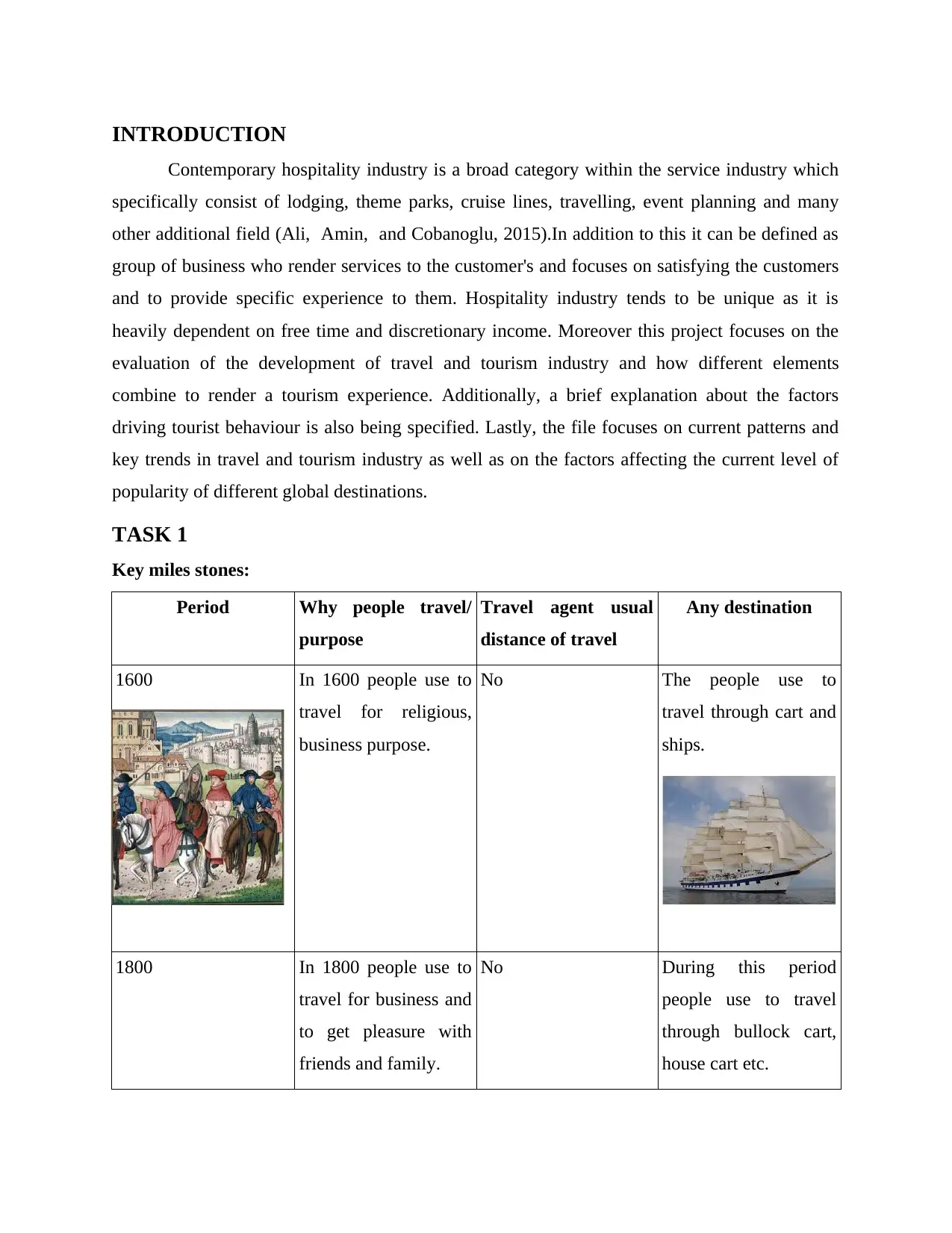
INTRODUCTION
Contemporary hospitality industry is a broad category within the service industry which
specifically consist of lodging, theme parks, cruise lines, travelling, event planning and many
other additional field (Ali, Amin, and Cobanoglu, 2015).In addition to this it can be defined as
group of business who render services to the customer's and focuses on satisfying the customers
and to provide specific experience to them. Hospitality industry tends to be unique as it is
heavily dependent on free time and discretionary income. Moreover this project focuses on the
evaluation of the development of travel and tourism industry and how different elements
combine to render a tourism experience. Additionally, a brief explanation about the factors
driving tourist behaviour is also being specified. Lastly, the file focuses on current patterns and
key trends in travel and tourism industry as well as on the factors affecting the current level of
popularity of different global destinations.
TASK 1
Key miles stones:
Period Why people travel/
purpose
Travel agent usual
distance of travel
Any destination
1600 In 1600 people use to
travel for religious,
business purpose.
No The people use to
travel through cart and
ships.
1800 In 1800 people use to
travel for business and
to get pleasure with
friends and family.
No During this period
people use to travel
through bullock cart,
house cart etc.
Contemporary hospitality industry is a broad category within the service industry which
specifically consist of lodging, theme parks, cruise lines, travelling, event planning and many
other additional field (Ali, Amin, and Cobanoglu, 2015).In addition to this it can be defined as
group of business who render services to the customer's and focuses on satisfying the customers
and to provide specific experience to them. Hospitality industry tends to be unique as it is
heavily dependent on free time and discretionary income. Moreover this project focuses on the
evaluation of the development of travel and tourism industry and how different elements
combine to render a tourism experience. Additionally, a brief explanation about the factors
driving tourist behaviour is also being specified. Lastly, the file focuses on current patterns and
key trends in travel and tourism industry as well as on the factors affecting the current level of
popularity of different global destinations.
TASK 1
Key miles stones:
Period Why people travel/
purpose
Travel agent usual
distance of travel
Any destination
1600 In 1600 people use to
travel for religious,
business purpose.
No The people use to
travel through cart and
ships.
1800 In 1800 people use to
travel for business and
to get pleasure with
friends and family.
No During this period
people use to travel
through bullock cart,
house cart etc.
⊘ This is a preview!⊘
Do you want full access?
Subscribe today to unlock all pages.

Trusted by 1+ million students worldwide
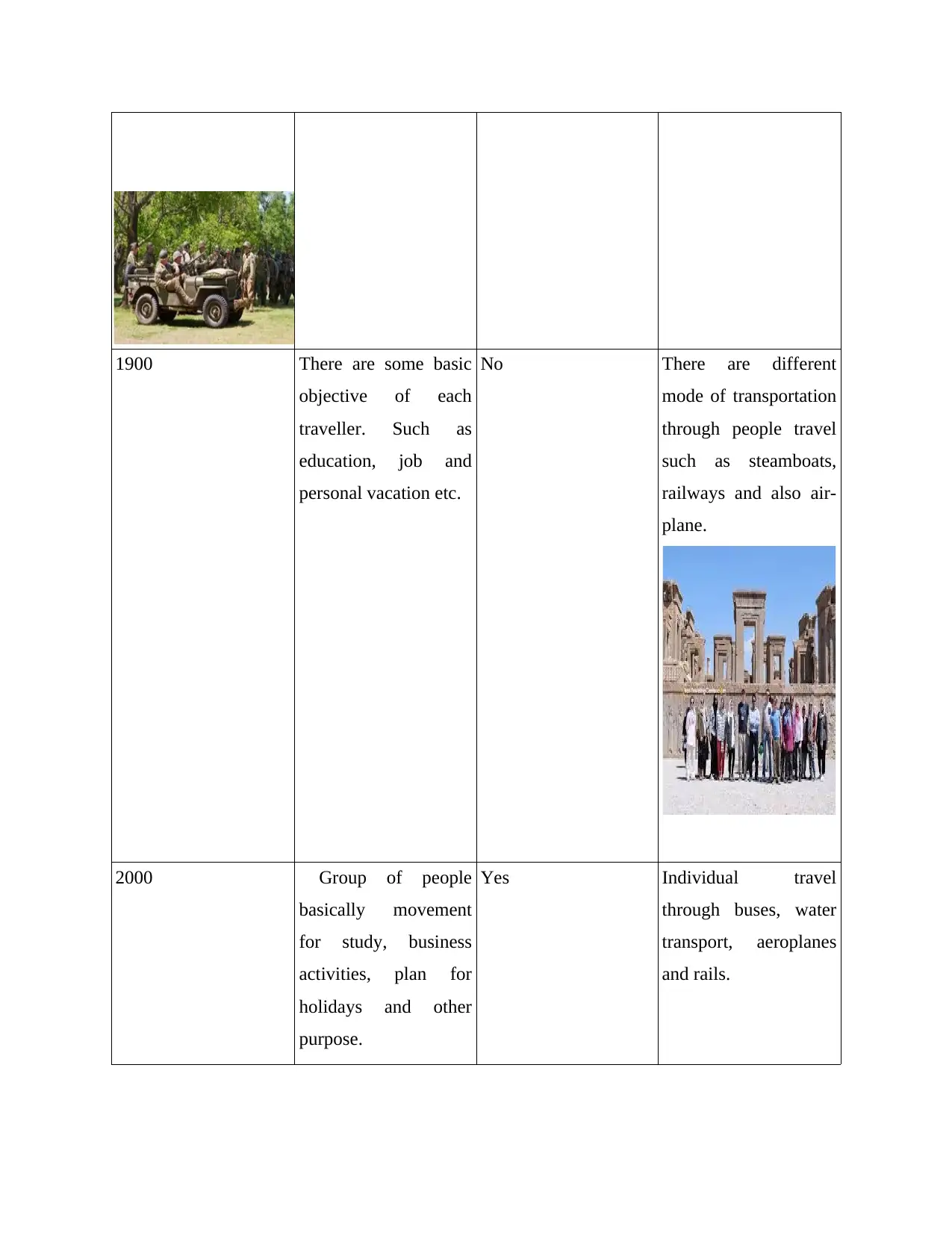
1900 There are some basic
objective of each
traveller. Such as
education, job and
personal vacation etc.
No There are different
mode of transportation
through people travel
such as steamboats,
railways and also air-
plane.
2000 Group of people
basically movement
for study, business
activities, plan for
holidays and other
purpose.
Yes Individual travel
through buses, water
transport, aeroplanes
and rails.
objective of each
traveller. Such as
education, job and
personal vacation etc.
No There are different
mode of transportation
through people travel
such as steamboats,
railways and also air-
plane.
2000 Group of people
basically movement
for study, business
activities, plan for
holidays and other
purpose.
Yes Individual travel
through buses, water
transport, aeroplanes
and rails.
Paraphrase This Document
Need a fresh take? Get an instant paraphrase of this document with our AI Paraphraser
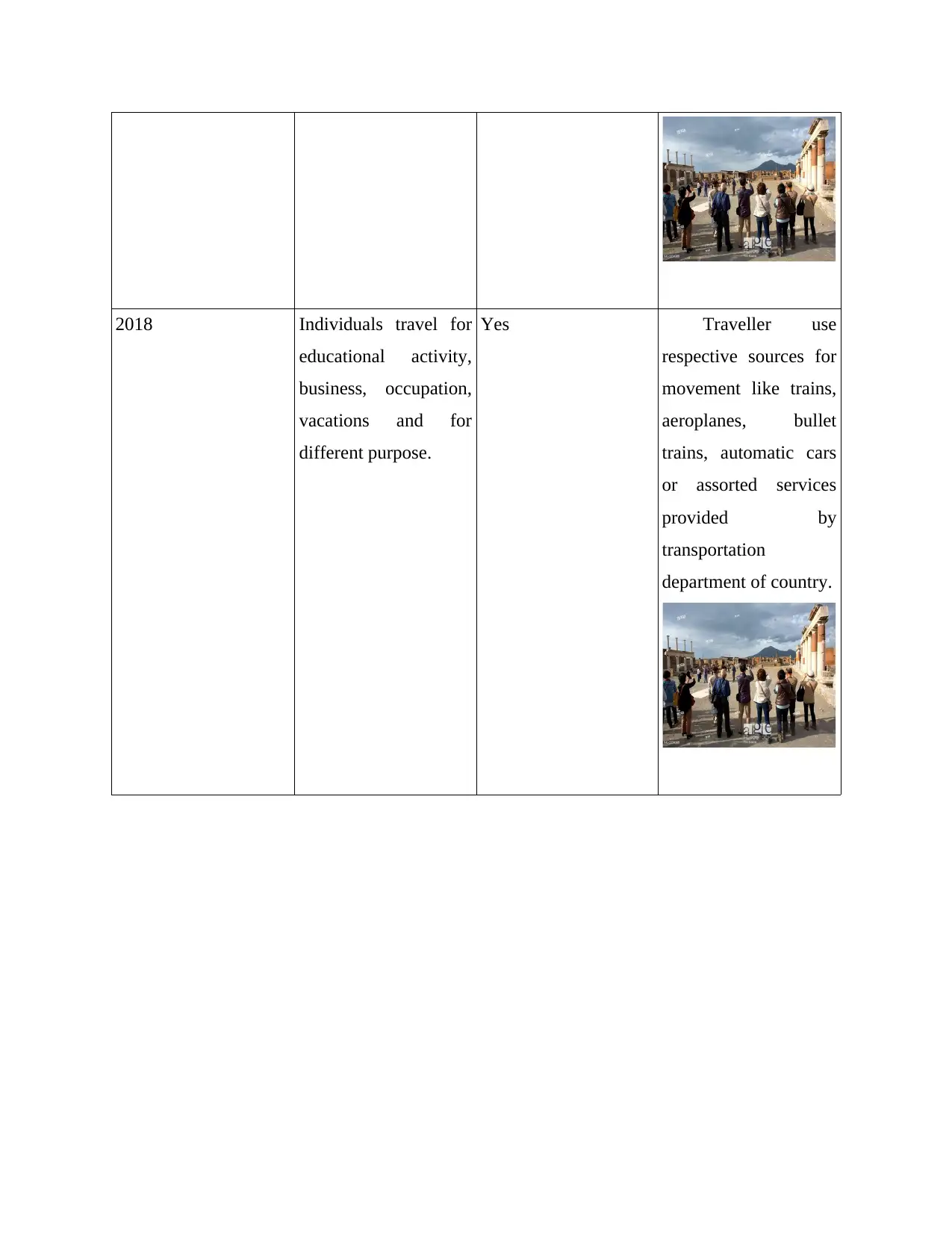
2018 Individuals travel for
educational activity,
business, occupation,
vacations and for
different purpose.
Yes Traveller use
respective sources for
movement like trains,
aeroplanes, bullet
trains, automatic cars
or assorted services
provided by
transportation
department of country.
educational activity,
business, occupation,
vacations and for
different purpose.
Yes Traveller use
respective sources for
movement like trains,
aeroplanes, bullet
trains, automatic cars
or assorted services
provided by
transportation
department of country.
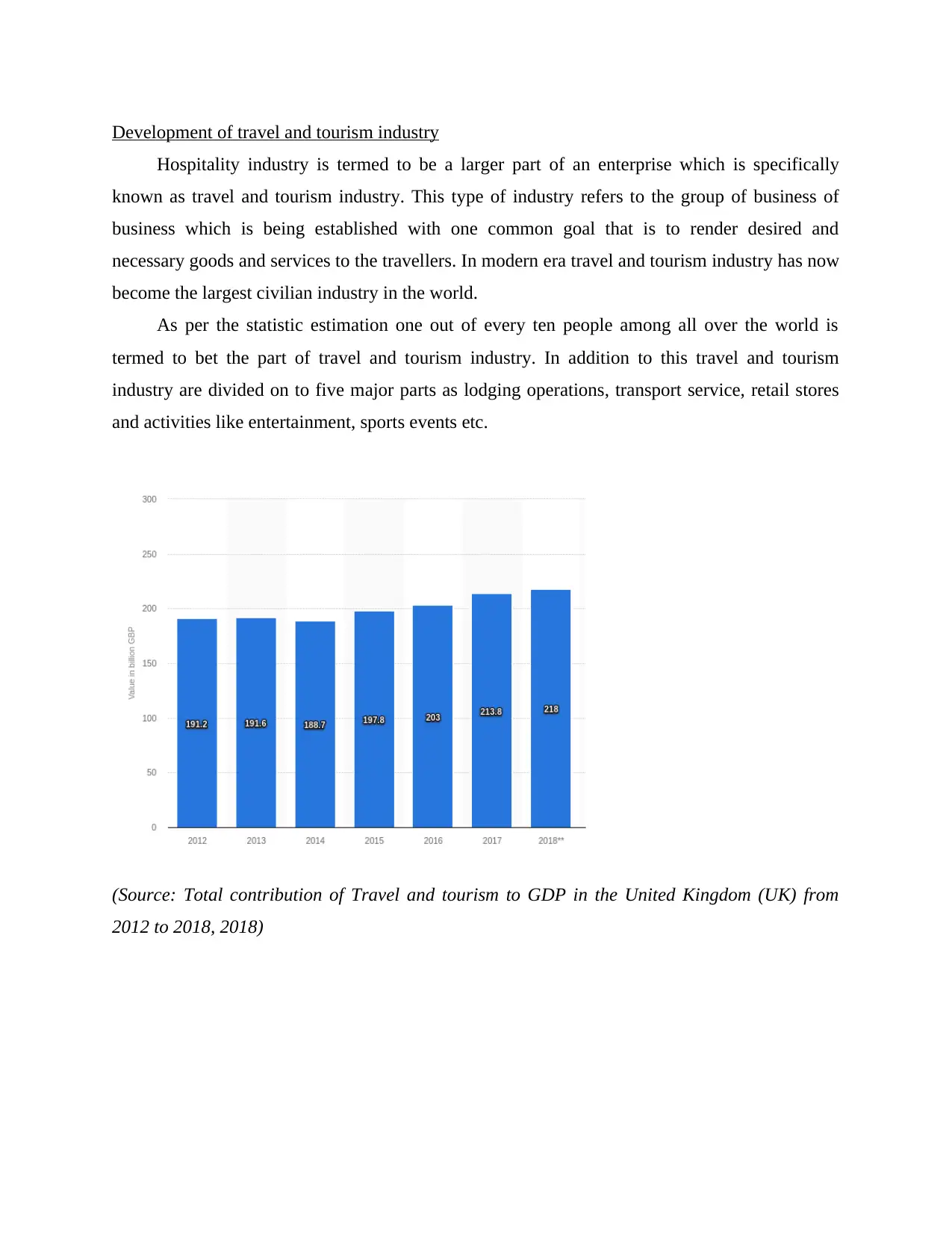
Development of travel and tourism industry
Hospitality industry is termed to be a larger part of an enterprise which is specifically
known as travel and tourism industry. This type of industry refers to the group of business of
business which is being established with one common goal that is to render desired and
necessary goods and services to the travellers. In modern era travel and tourism industry has now
become the largest civilian industry in the world.
As per the statistic estimation one out of every ten people among all over the world is
termed to bet the part of travel and tourism industry. In addition to this travel and tourism
industry are divided on to five major parts as lodging operations, transport service, retail stores
and activities like entertainment, sports events etc.
(Source: Total contribution of Travel and tourism to GDP in the United Kingdom (UK) from
2012 to 2018, 2018)
Hospitality industry is termed to be a larger part of an enterprise which is specifically
known as travel and tourism industry. This type of industry refers to the group of business of
business which is being established with one common goal that is to render desired and
necessary goods and services to the travellers. In modern era travel and tourism industry has now
become the largest civilian industry in the world.
As per the statistic estimation one out of every ten people among all over the world is
termed to bet the part of travel and tourism industry. In addition to this travel and tourism
industry are divided on to five major parts as lodging operations, transport service, retail stores
and activities like entertainment, sports events etc.
(Source: Total contribution of Travel and tourism to GDP in the United Kingdom (UK) from
2012 to 2018, 2018)
⊘ This is a preview!⊘
Do you want full access?
Subscribe today to unlock all pages.

Trusted by 1+ million students worldwide

Paraphrase This Document
Need a fresh take? Get an instant paraphrase of this document with our AI Paraphraser
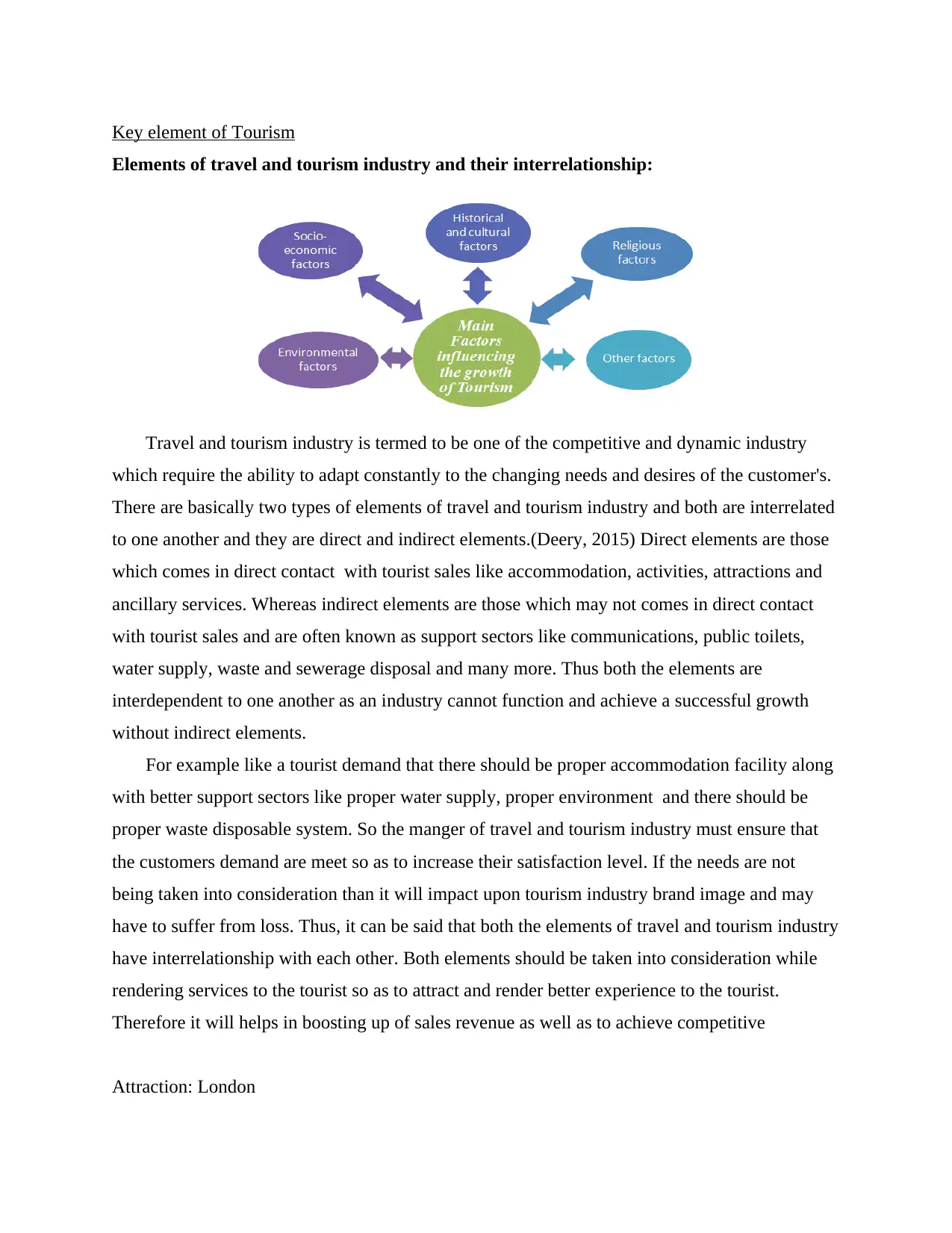
Key element of Tourism
Elements of travel and tourism industry and their interrelationship:
Travel and tourism industry is termed to be one of the competitive and dynamic industry
which require the ability to adapt constantly to the changing needs and desires of the customer's.
There are basically two types of elements of travel and tourism industry and both are interrelated
to one another and they are direct and indirect elements.(Deery, 2015) Direct elements are those
which comes in direct contact with tourist sales like accommodation, activities, attractions and
ancillary services. Whereas indirect elements are those which may not comes in direct contact
with tourist sales and are often known as support sectors like communications, public toilets,
water supply, waste and sewerage disposal and many more. Thus both the elements are
interdependent to one another as an industry cannot function and achieve a successful growth
without indirect elements.
For example like a tourist demand that there should be proper accommodation facility along
with better support sectors like proper water supply, proper environment and there should be
proper waste disposable system. So the manger of travel and tourism industry must ensure that
the customers demand are meet so as to increase their satisfaction level. If the needs are not
being taken into consideration than it will impact upon tourism industry brand image and may
have to suffer from loss. Thus, it can be said that both the elements of travel and tourism industry
have interrelationship with each other. Both elements should be taken into consideration while
rendering services to the tourist so as to attract and render better experience to the tourist.
Therefore it will helps in boosting up of sales revenue as well as to achieve competitive
Attraction: London
Elements of travel and tourism industry and their interrelationship:
Travel and tourism industry is termed to be one of the competitive and dynamic industry
which require the ability to adapt constantly to the changing needs and desires of the customer's.
There are basically two types of elements of travel and tourism industry and both are interrelated
to one another and they are direct and indirect elements.(Deery, 2015) Direct elements are those
which comes in direct contact with tourist sales like accommodation, activities, attractions and
ancillary services. Whereas indirect elements are those which may not comes in direct contact
with tourist sales and are often known as support sectors like communications, public toilets,
water supply, waste and sewerage disposal and many more. Thus both the elements are
interdependent to one another as an industry cannot function and achieve a successful growth
without indirect elements.
For example like a tourist demand that there should be proper accommodation facility along
with better support sectors like proper water supply, proper environment and there should be
proper waste disposable system. So the manger of travel and tourism industry must ensure that
the customers demand are meet so as to increase their satisfaction level. If the needs are not
being taken into consideration than it will impact upon tourism industry brand image and may
have to suffer from loss. Thus, it can be said that both the elements of travel and tourism industry
have interrelationship with each other. Both elements should be taken into consideration while
rendering services to the tourist so as to attract and render better experience to the tourist.
Therefore it will helps in boosting up of sales revenue as well as to achieve competitive
Attraction: London
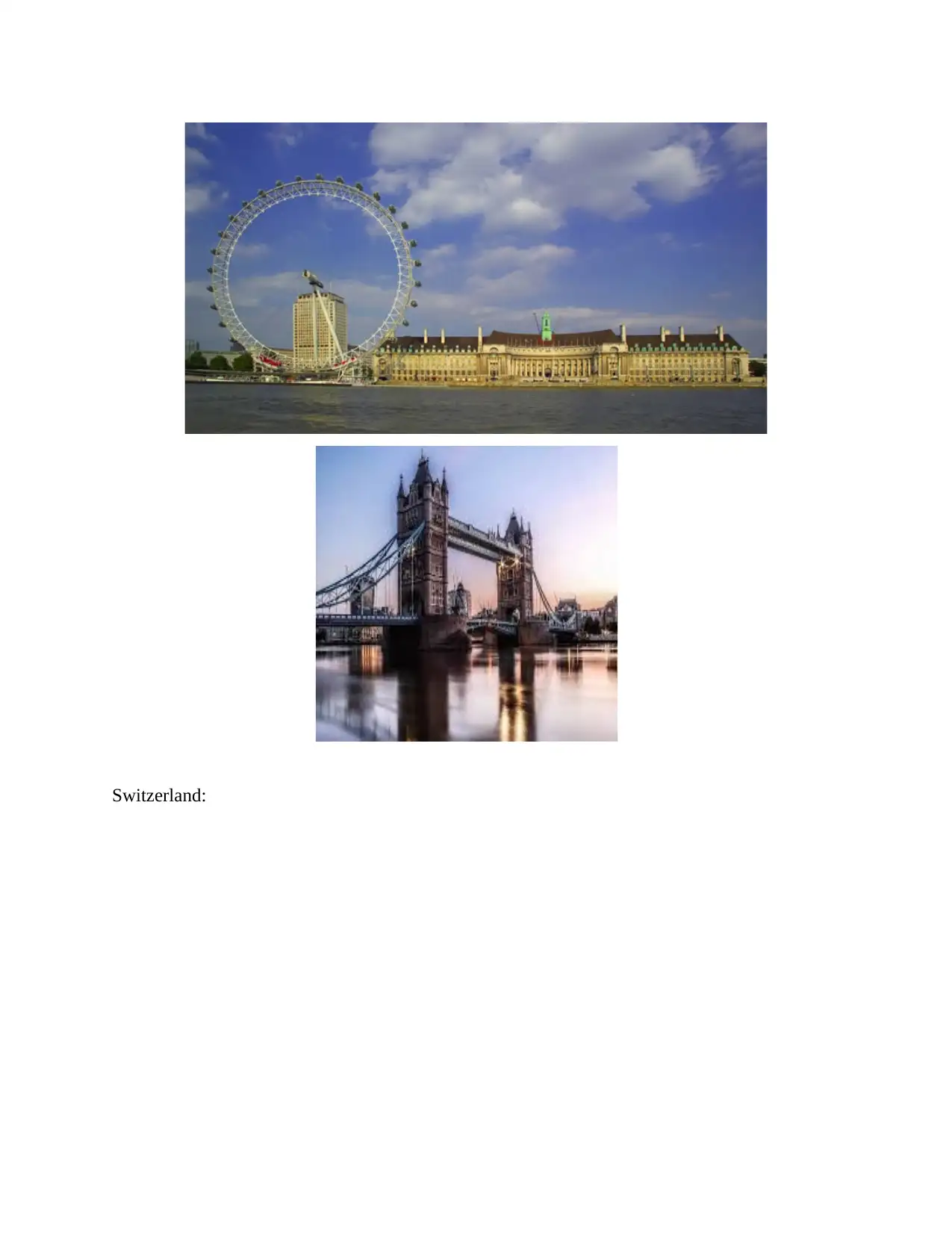
Switzerland:
⊘ This is a preview!⊘
Do you want full access?
Subscribe today to unlock all pages.

Trusted by 1+ million students worldwide
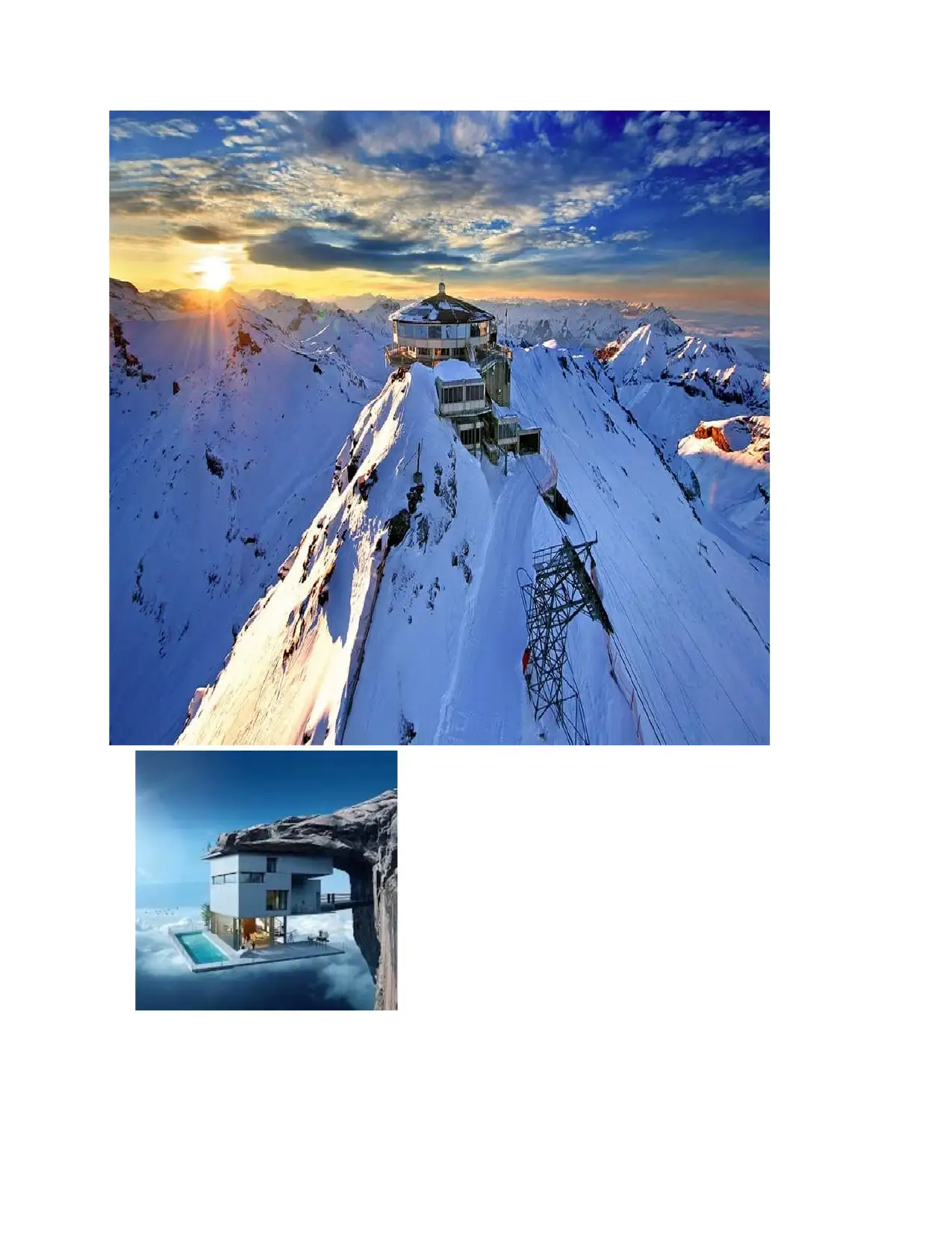
Paraphrase This Document
Need a fresh take? Get an instant paraphrase of this document with our AI Paraphraser

TASK 2, 3 & 4
Covered in PPT
Covered in PPT
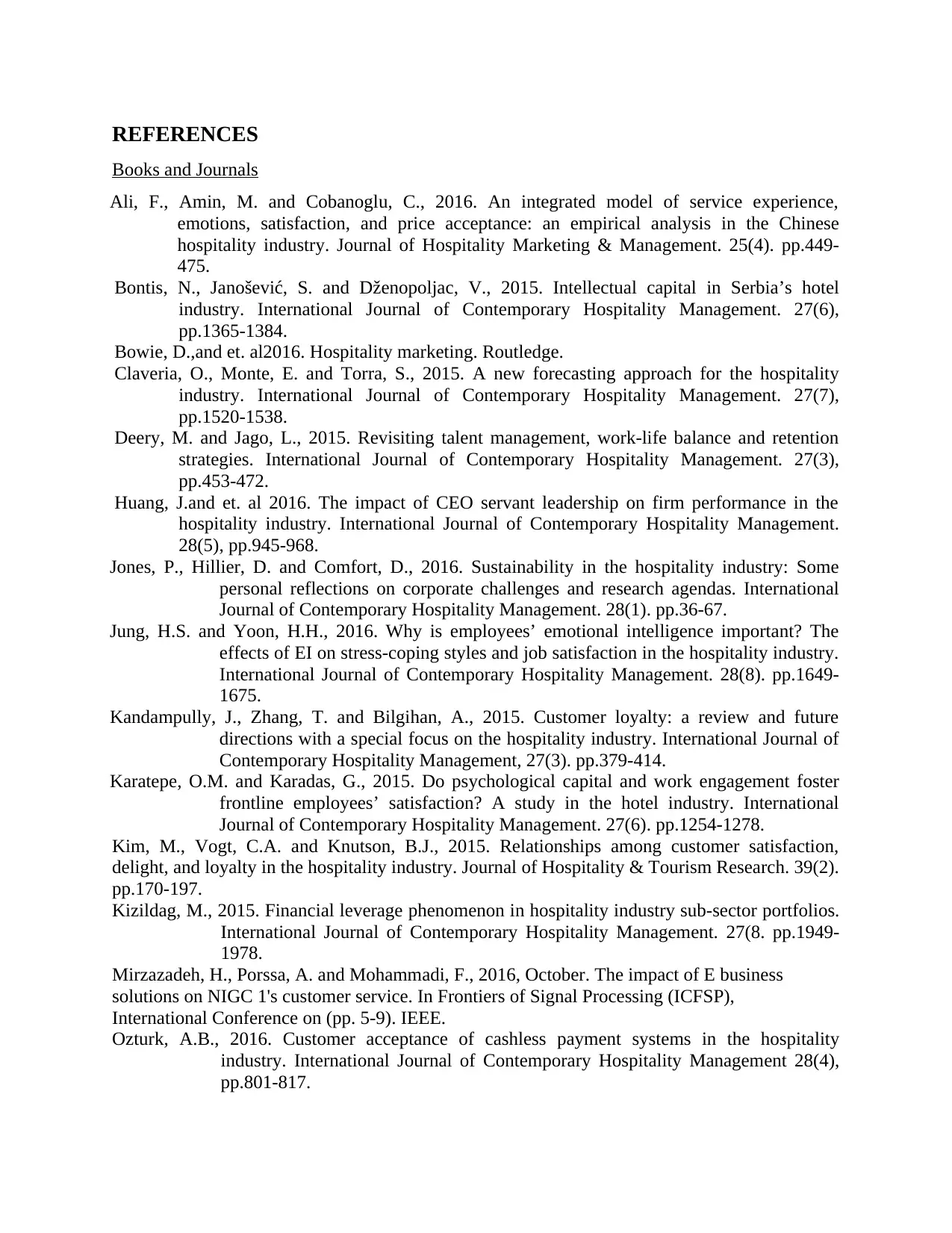
REFERENCES
Books and Journals
Ali, F., Amin, M. and Cobanoglu, C., 2016. An integrated model of service experience,
emotions, satisfaction, and price acceptance: an empirical analysis in the Chinese
hospitality industry. Journal of Hospitality Marketing & Management. 25(4). pp.449-
475.
Bontis, N., Janošević, S. and Dženopoljac, V., 2015. Intellectual capital in Serbia’s hotel
industry. International Journal of Contemporary Hospitality Management. 27(6),
pp.1365-1384.
Bowie, D.,and et. al2016. Hospitality marketing. Routledge.
Claveria, O., Monte, E. and Torra, S., 2015. A new forecasting approach for the hospitality
industry. International Journal of Contemporary Hospitality Management. 27(7),
pp.1520-1538.
Deery, M. and Jago, L., 2015. Revisiting talent management, work-life balance and retention
strategies. International Journal of Contemporary Hospitality Management. 27(3),
pp.453-472.
Huang, J.and et. al 2016. The impact of CEO servant leadership on firm performance in the
hospitality industry. International Journal of Contemporary Hospitality Management.
28(5), pp.945-968.
Jones, P., Hillier, D. and Comfort, D., 2016. Sustainability in the hospitality industry: Some
personal reflections on corporate challenges and research agendas. International
Journal of Contemporary Hospitality Management. 28(1). pp.36-67.
Jung, H.S. and Yoon, H.H., 2016. Why is employees’ emotional intelligence important? The
effects of EI on stress-coping styles and job satisfaction in the hospitality industry.
International Journal of Contemporary Hospitality Management. 28(8). pp.1649-
1675.
Kandampully, J., Zhang, T. and Bilgihan, A., 2015. Customer loyalty: a review and future
directions with a special focus on the hospitality industry. International Journal of
Contemporary Hospitality Management, 27(3). pp.379-414.
Karatepe, O.M. and Karadas, G., 2015. Do psychological capital and work engagement foster
frontline employees’ satisfaction? A study in the hotel industry. International
Journal of Contemporary Hospitality Management. 27(6). pp.1254-1278.
Kim, M., Vogt, C.A. and Knutson, B.J., 2015. Relationships among customer satisfaction,
delight, and loyalty in the hospitality industry. Journal of Hospitality & Tourism Research. 39(2).
pp.170-197.
Kizildag, M., 2015. Financial leverage phenomenon in hospitality industry sub-sector portfolios.
International Journal of Contemporary Hospitality Management. 27(8. pp.1949-
1978.
Mirzazadeh, H., Porssa, A. and Mohammadi, F., 2016, October. The impact of E business
solutions on NIGC 1's customer service. In Frontiers of Signal Processing (ICFSP),
International Conference on (pp. 5-9). IEEE.
Ozturk, A.B., 2016. Customer acceptance of cashless payment systems in the hospitality
industry. International Journal of Contemporary Hospitality Management 28(4),
pp.801-817.
Books and Journals
Ali, F., Amin, M. and Cobanoglu, C., 2016. An integrated model of service experience,
emotions, satisfaction, and price acceptance: an empirical analysis in the Chinese
hospitality industry. Journal of Hospitality Marketing & Management. 25(4). pp.449-
475.
Bontis, N., Janošević, S. and Dženopoljac, V., 2015. Intellectual capital in Serbia’s hotel
industry. International Journal of Contemporary Hospitality Management. 27(6),
pp.1365-1384.
Bowie, D.,and et. al2016. Hospitality marketing. Routledge.
Claveria, O., Monte, E. and Torra, S., 2015. A new forecasting approach for the hospitality
industry. International Journal of Contemporary Hospitality Management. 27(7),
pp.1520-1538.
Deery, M. and Jago, L., 2015. Revisiting talent management, work-life balance and retention
strategies. International Journal of Contemporary Hospitality Management. 27(3),
pp.453-472.
Huang, J.and et. al 2016. The impact of CEO servant leadership on firm performance in the
hospitality industry. International Journal of Contemporary Hospitality Management.
28(5), pp.945-968.
Jones, P., Hillier, D. and Comfort, D., 2016. Sustainability in the hospitality industry: Some
personal reflections on corporate challenges and research agendas. International
Journal of Contemporary Hospitality Management. 28(1). pp.36-67.
Jung, H.S. and Yoon, H.H., 2016. Why is employees’ emotional intelligence important? The
effects of EI on stress-coping styles and job satisfaction in the hospitality industry.
International Journal of Contemporary Hospitality Management. 28(8). pp.1649-
1675.
Kandampully, J., Zhang, T. and Bilgihan, A., 2015. Customer loyalty: a review and future
directions with a special focus on the hospitality industry. International Journal of
Contemporary Hospitality Management, 27(3). pp.379-414.
Karatepe, O.M. and Karadas, G., 2015. Do psychological capital and work engagement foster
frontline employees’ satisfaction? A study in the hotel industry. International
Journal of Contemporary Hospitality Management. 27(6). pp.1254-1278.
Kim, M., Vogt, C.A. and Knutson, B.J., 2015. Relationships among customer satisfaction,
delight, and loyalty in the hospitality industry. Journal of Hospitality & Tourism Research. 39(2).
pp.170-197.
Kizildag, M., 2015. Financial leverage phenomenon in hospitality industry sub-sector portfolios.
International Journal of Contemporary Hospitality Management. 27(8. pp.1949-
1978.
Mirzazadeh, H., Porssa, A. and Mohammadi, F., 2016, October. The impact of E business
solutions on NIGC 1's customer service. In Frontiers of Signal Processing (ICFSP),
International Conference on (pp. 5-9). IEEE.
Ozturk, A.B., 2016. Customer acceptance of cashless payment systems in the hospitality
industry. International Journal of Contemporary Hospitality Management 28(4),
pp.801-817.
⊘ This is a preview!⊘
Do you want full access?
Subscribe today to unlock all pages.

Trusted by 1+ million students worldwide
1 out of 13
Related Documents
Your All-in-One AI-Powered Toolkit for Academic Success.
+13062052269
info@desklib.com
Available 24*7 on WhatsApp / Email
![[object Object]](/_next/static/media/star-bottom.7253800d.svg)
Unlock your academic potential
Copyright © 2020–2025 A2Z Services. All Rights Reserved. Developed and managed by ZUCOL.





![Contemporary Travel and Tourism Industry Report - [University Name]](/_next/image/?url=https%3A%2F%2Fdesklib.com%2Fmedia%2Fimages%2Ftg%2F12fecf8882dc422db56286f3591ad2e5.jpg&w=256&q=75)